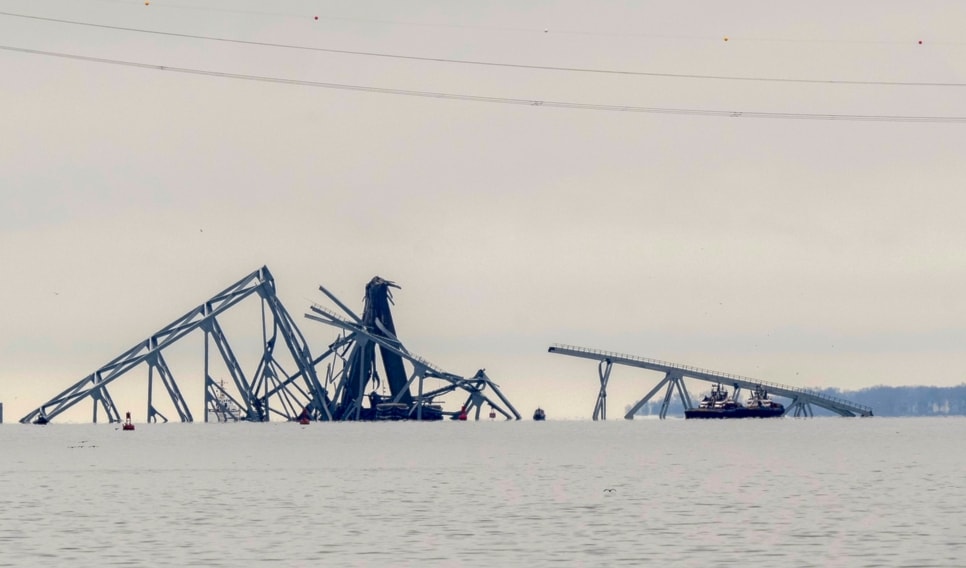Details from Baltimore bridge collapse emerge, two bodies retrieved
Following the fatal crash of the Dali ship into the Francis Scott Key Bridge, information obtained from the ship's audio box uncovers the events of the moments before the crash.
-

Wreckage of the Francis Scott Key Bridge is pictured on Wednesday, March 27, 2024, in Baltimore. (AP)
New details have emerged regarding the collapse of the Francis Scott Key Bridge in the city of Baltimore, Maryland, in the US, following a Singapore-flagged ship's collision with the bridge.
The footage shows that moments before the crash, the ship had lost power and ability to steer the ship.
Federal safety officials reported on Wednesday that they obtained recordings from the ship's audio box, which shows the captain of the ship requesting tugboat help and reporting a loss of power, just minutes before the fatal crash.
The head of the National Transportation Safety Board also added that the bridge itself did not have a solid foundation, and "lacked structural engineering redundancies," which makes it susceptible to collapses.
Six workers went missing below the surface following the crash. However, the bodies of Alejandro Hernandez Fuentes, 35, and Dorlian Ronial Castillo Cabrera, 26, were retrieved by authorities. Maryland State Police Colonel Roland Butler said the bodies were found in a pickup truck 25 feet below water, near the middle section of the bridge.
He ordered authorities to resume efforts to retrieve the four remaining bodies, especially considering the risky nature of the vicinity, which is now filled with wreckage and submerged vehicles that are becoming harder to reach.
Earlier on Tuesday, two workers caught in the wreckage were rescued, with one currently being hospitalized.
Investigation
On Wednesday, the NTSB conducted interviews with the ship's two pilots and 21 crew members who survived the crash, while investigators examined audio from the vessel's Voyage Data Recorder.
The captain was heard calling for tugboat assistance as the ship lost power and pilots lost control of the panels, making it harder to maneuver the ship. Simultaneously, the captain warned shore-based authorities that the vessel was closing in on the bridge, minutes before colliding with it.
The crew was ordered to drop anchor to slow down the ship, whose speed stood at 8 miles per hour.
Emergency radio chatter was also obtained and examined, and indicated the chaos that unfolded as the ship neared the bridge. While a crash was inevitable, it should be noted that shore authorities attempted to save as many lives as they could. "Hold all traffic on the Key Bridge. There's a ship approaching that just lost their steering," a port personnel was heard saying over a police radio.
While commands were given to abandon the bridge and head to safety, as Dali, the vessel approached further, a voice heard on the intercom interrupts the chatter and announces that the entirety of the bridge collapsed.
Vice Admiral Peter Gautier, speaking at a White House press conference, emphasized that the primary focus of the US Coast Guard is to reopen the waterway for shipping, stabilize the damaged vessel, and remove it.
He also mentioned that among the 4,700 cargo containers on the ship, 56 contain hazardous materials, but reassured that there is no danger to the public. Additionally, Gautier noted that two containers that do not contain hazardous material fell overboard during the incident. He further stated that the ship was transporting over 1.5 million gallons of fuel oil.
The domino effect of the collapse
The Francis Scott Key Bridge was an essential port for RoRo shipments. Its collapse caused the shutdown of maritime shipments at Baltimore Port, and is expected to incur profound economic ramifications.
Annually, the port handles at least $80 billion from 52 million tonnes of international cargo, and manages significant imports such as sugar and gypsum. It is also directly responsible for 15,000 jobs, and linked to 139,000 jobs nationwide.
In this context, the port generated $3.3 billion in personal income and generated at least $400 million in annual tax revenues.
Considering the economic importance of the bridge, its collapse would have severe consequences on the stability of the economy. The Maryland Chamber of Commerce said the collapse will "inevitably disrupt commercial activities and supply chains", a fact echoed by exonomists, who said a major US supply chain crisis could be triggered, causing an increase in price points of commercial goods due to the "ample capacity at rival shipping hubs" along the East Coast.

 4 Min Read
4 Min Read








